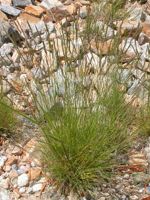Mon-Fri 9am - 5pm Mountain time
Idaho Fescue vs Blue Flax
Festuca idahoensis
Linum lewisii
CUSTOM GROW
NOT AVAILABLE THIS SEASON - MIGHT RETURN
Idaho Fescue is a native perennial bunchgrass recognized for its fine-textured, blue-green foliage. Its dense, tufted growth and deep root system make it drought-tolerant and effective at stabilizing soils, particularly on slopes and open grasslands. Its upright, arching form and dense clumps give it strong ornamental value in both natural and designed landscapes.
This hardy grass provides cover for wildlife and forage for grazing animals, while also supporting soil health and habitat diversity. Idaho Fescue is well-suited for erosion control, ecological restoration, naturalization, xeriscaping, and habitat enhancement projects.
Blue Flax is a native perennial wildflower known for its blue to violet flowers. Each flower lasts just a single day, but new blooms appear continuously, providing weeks of colour. This extended flowering period provides a reliable display from late spring into summer and attracts a variety of pollinators.
They can self-seed readily, so removing spent blooms helps manage their spread. Birds feed on the seeds, and when cooked, they are edible and are described as having a mild, nutty flavour. The plant grows in loose clumps with slender stems and fine foliage. Young plants are leafy, but as they mature, most leaves are shed.
Blue Flax grows well in a wide range of soils, including poor or sandy conditions, and is drought-tolerant once established. The deep root system helps to stabilize soil and prevent erosion. They are well-suited for pollinator gardens, restoration, naturalization, and xeriscaping projects.
Idaho Fescue Quick Facts
Blue Flax Quick Facts
Toxicity: toxic to some animals, raw seed toxic

